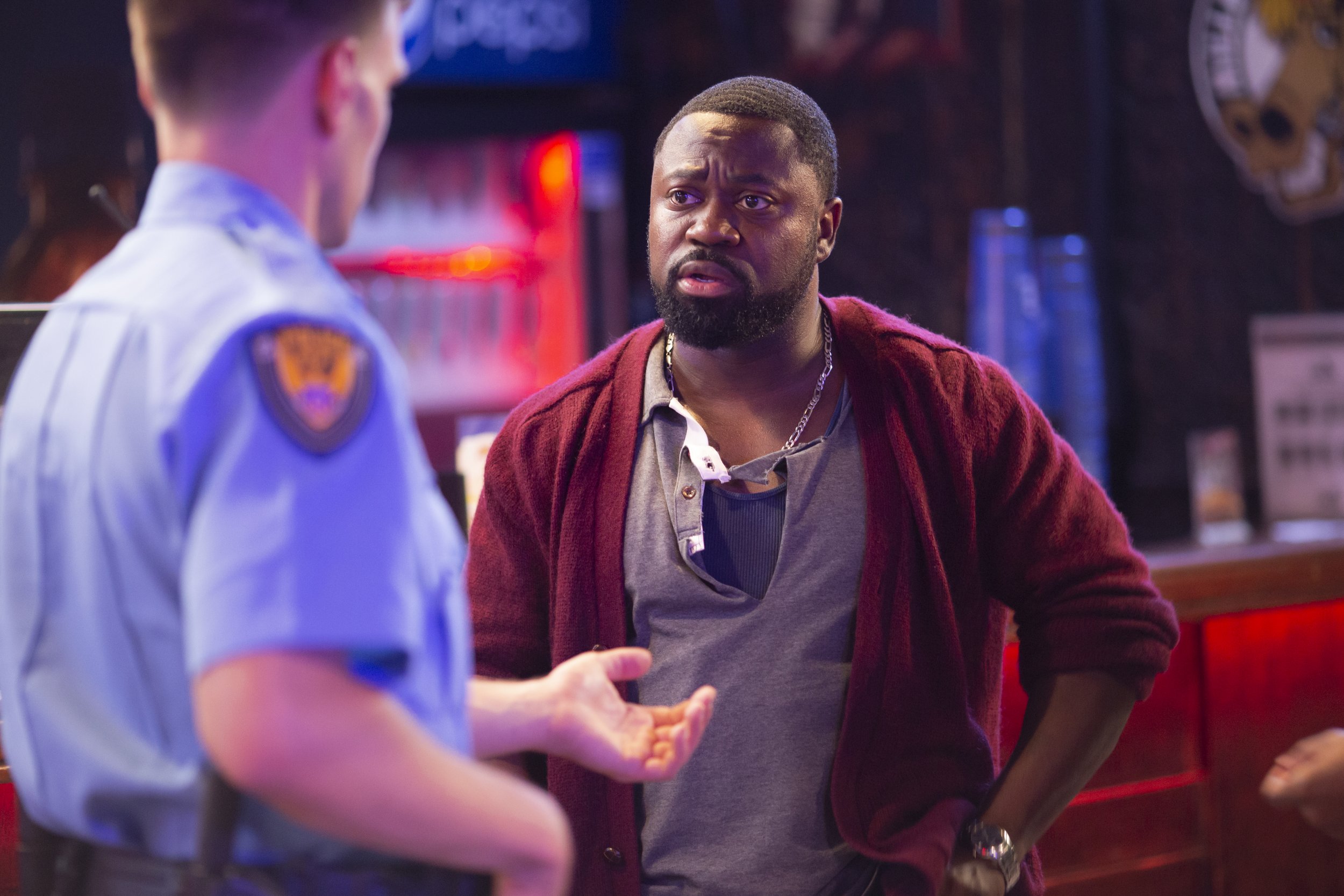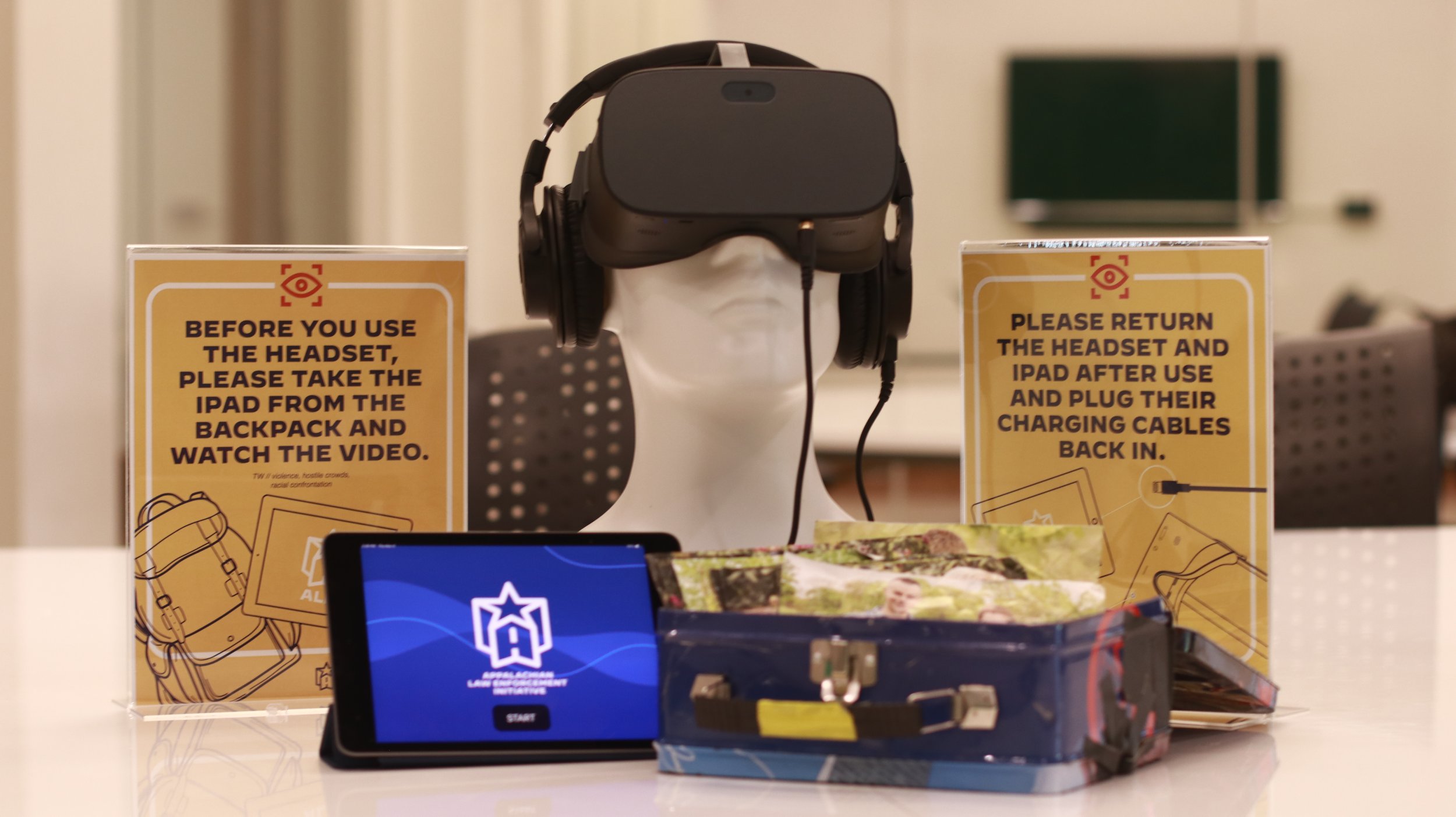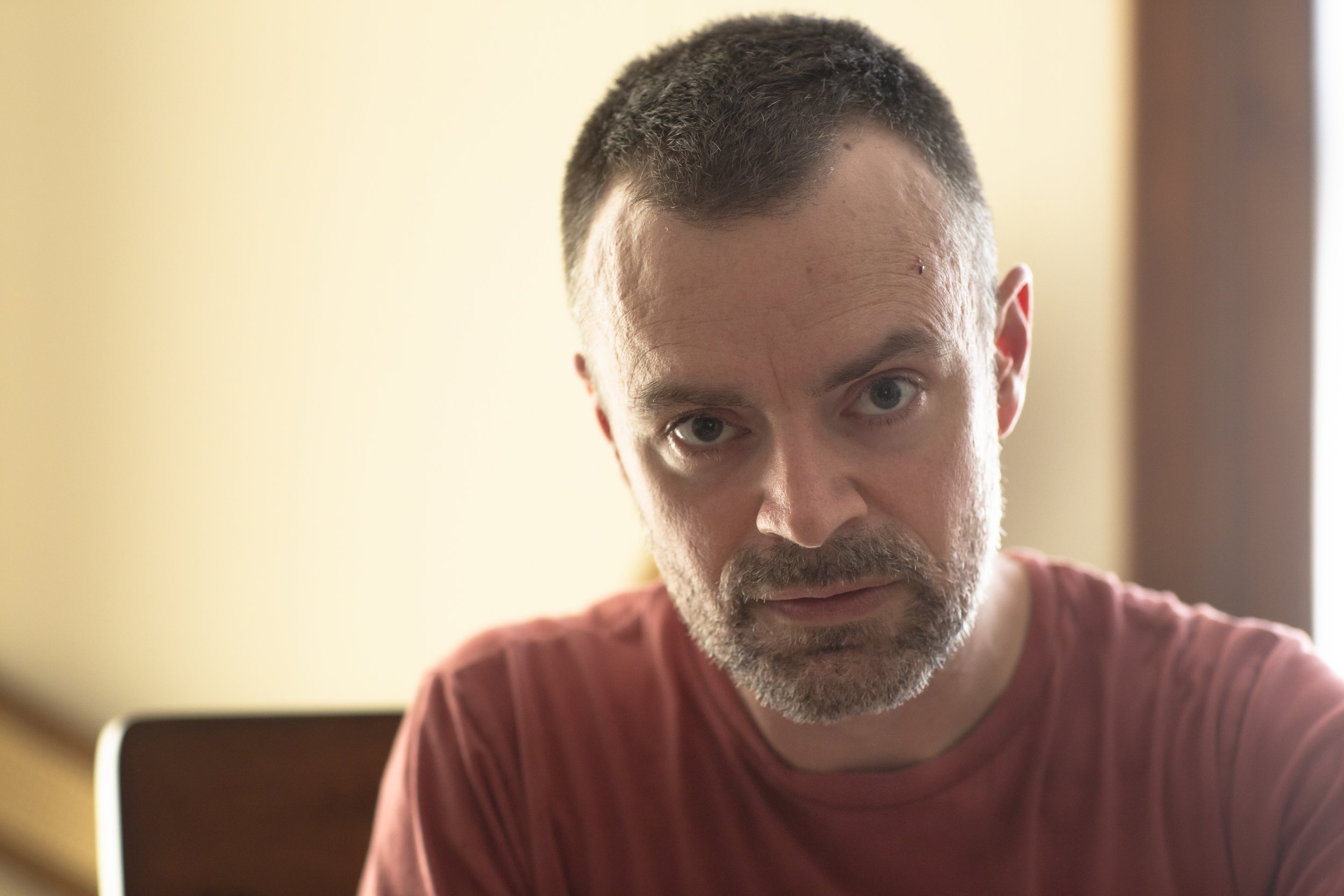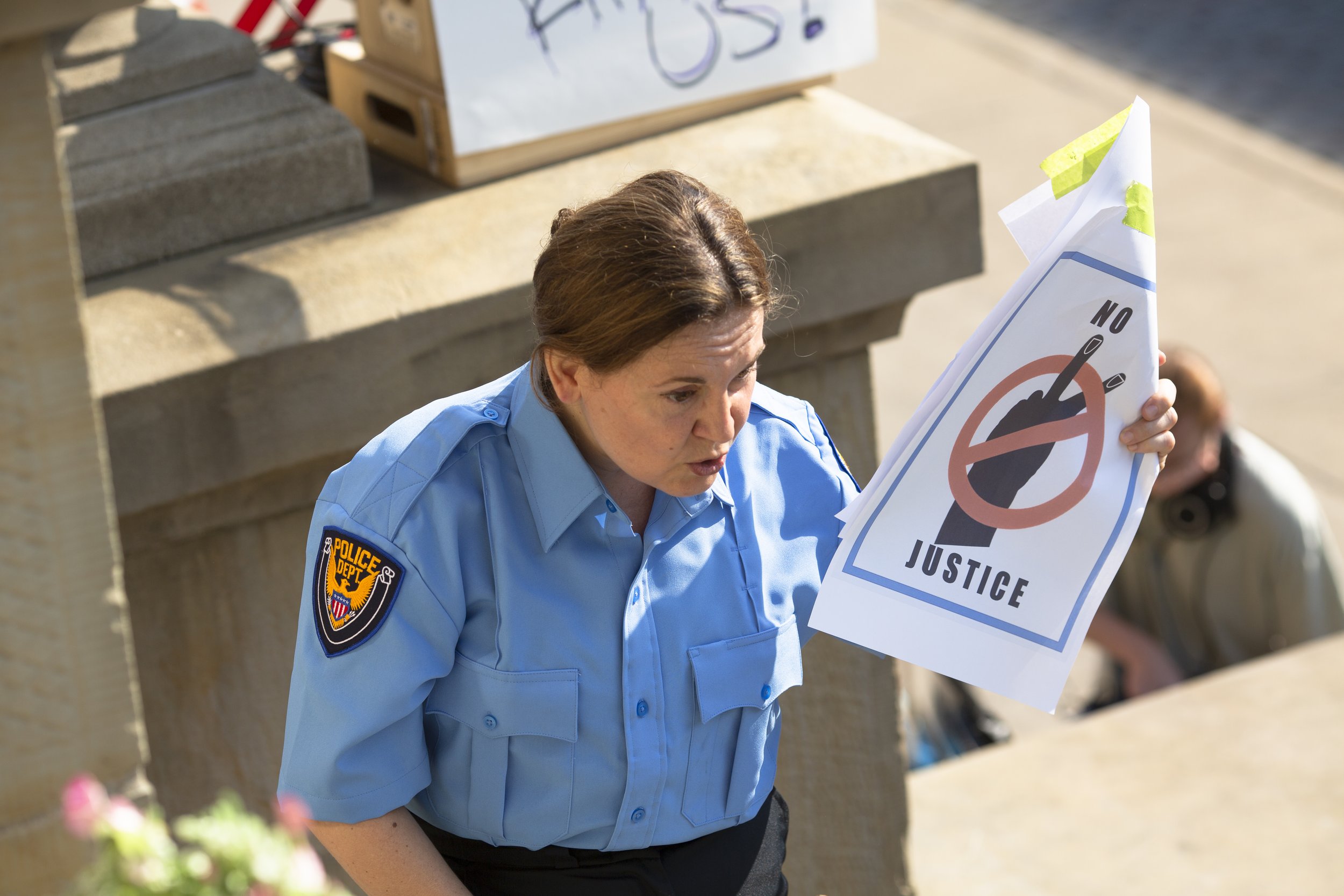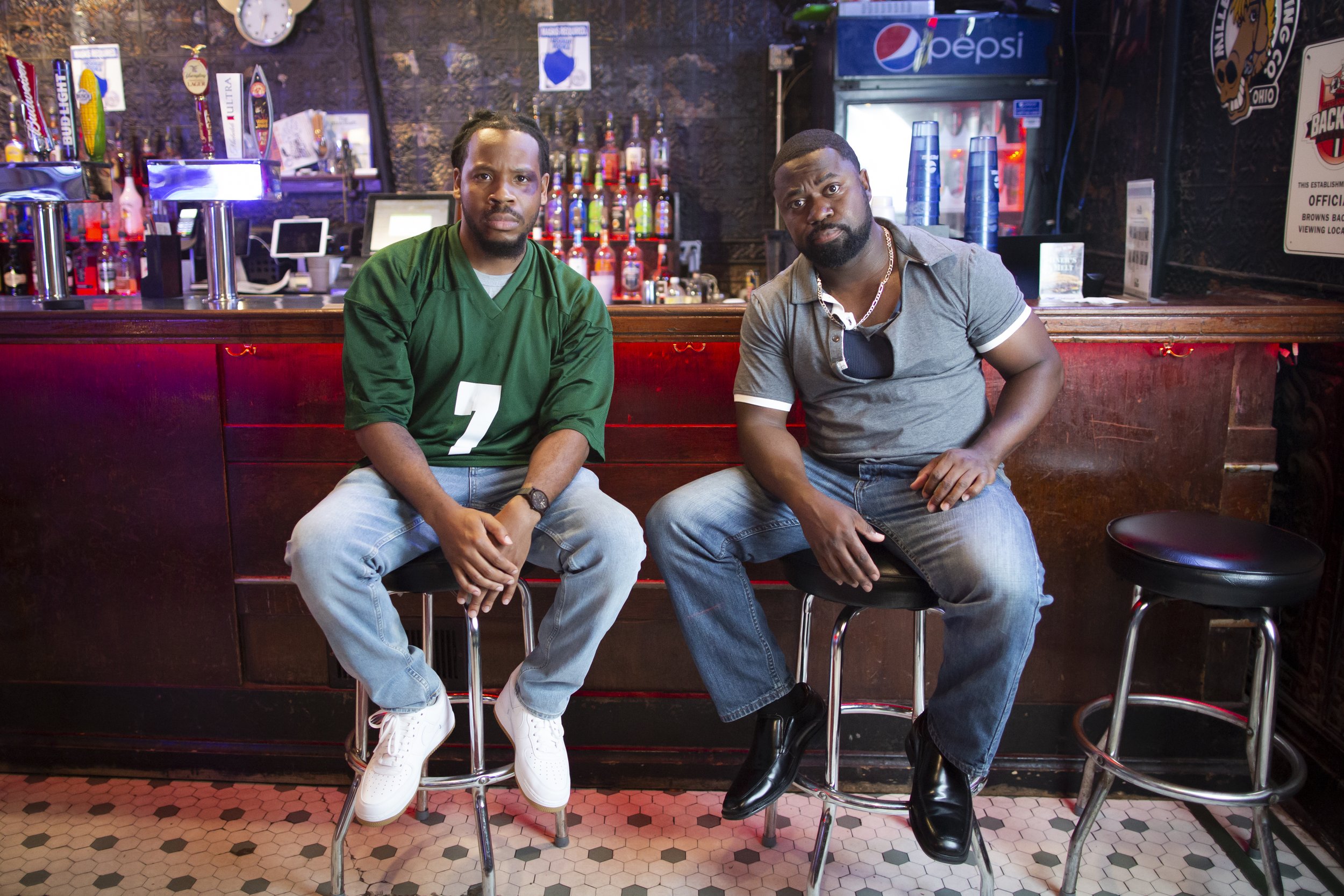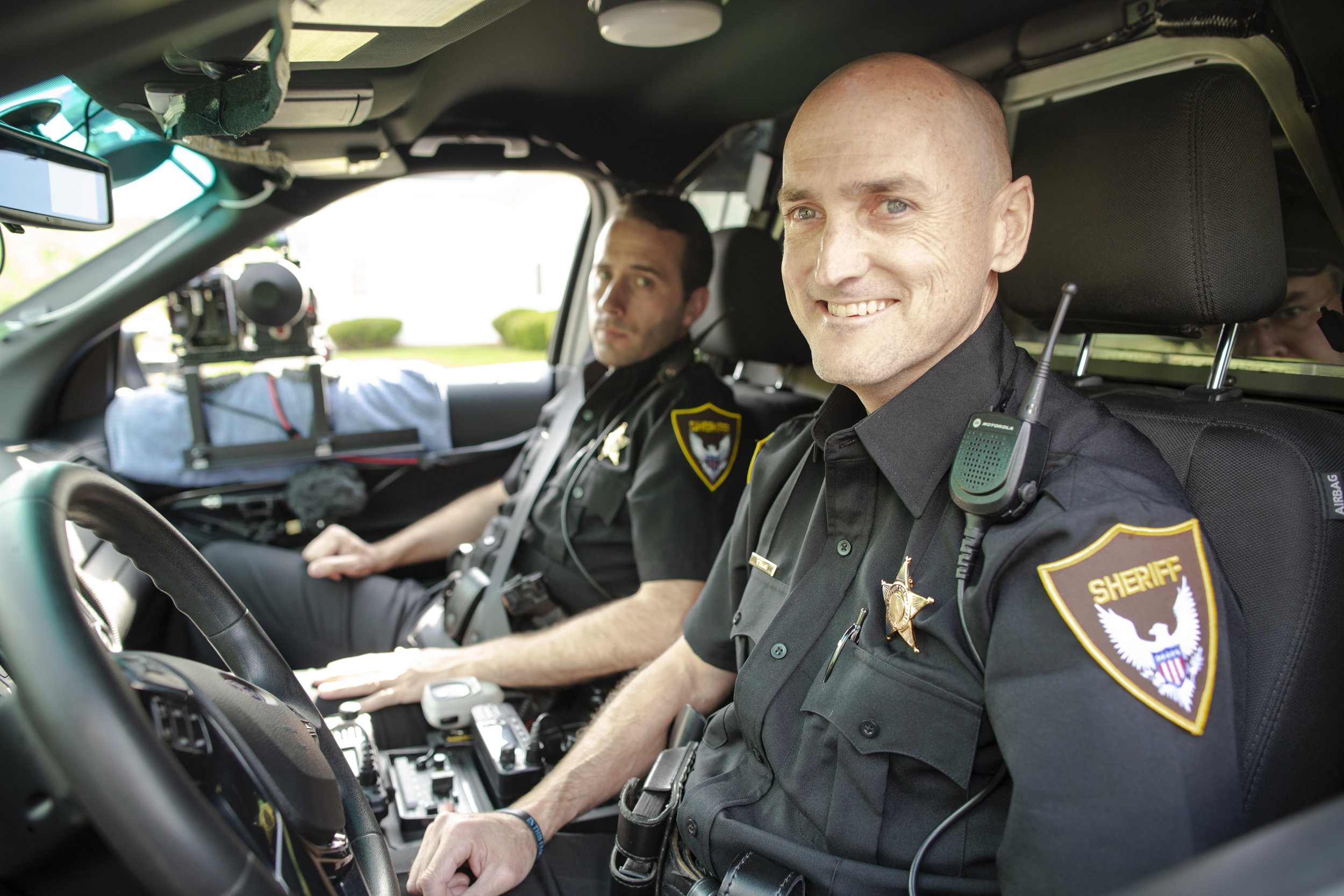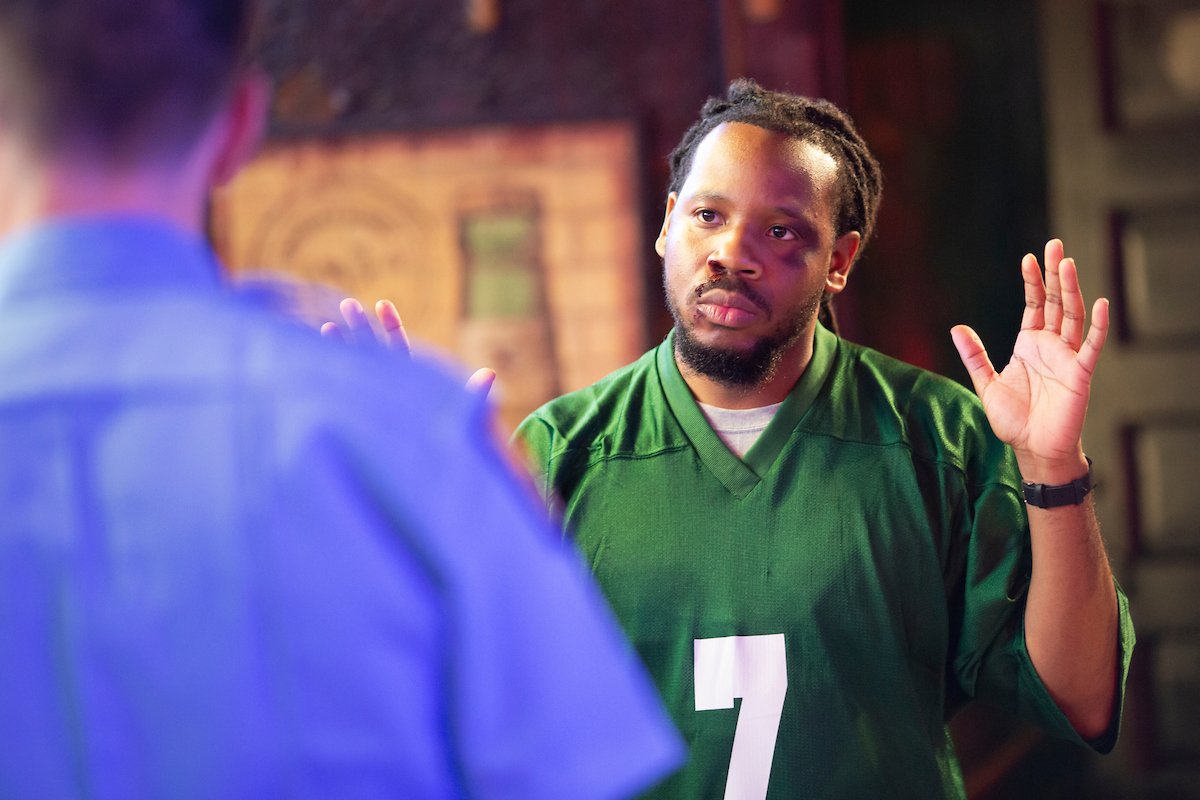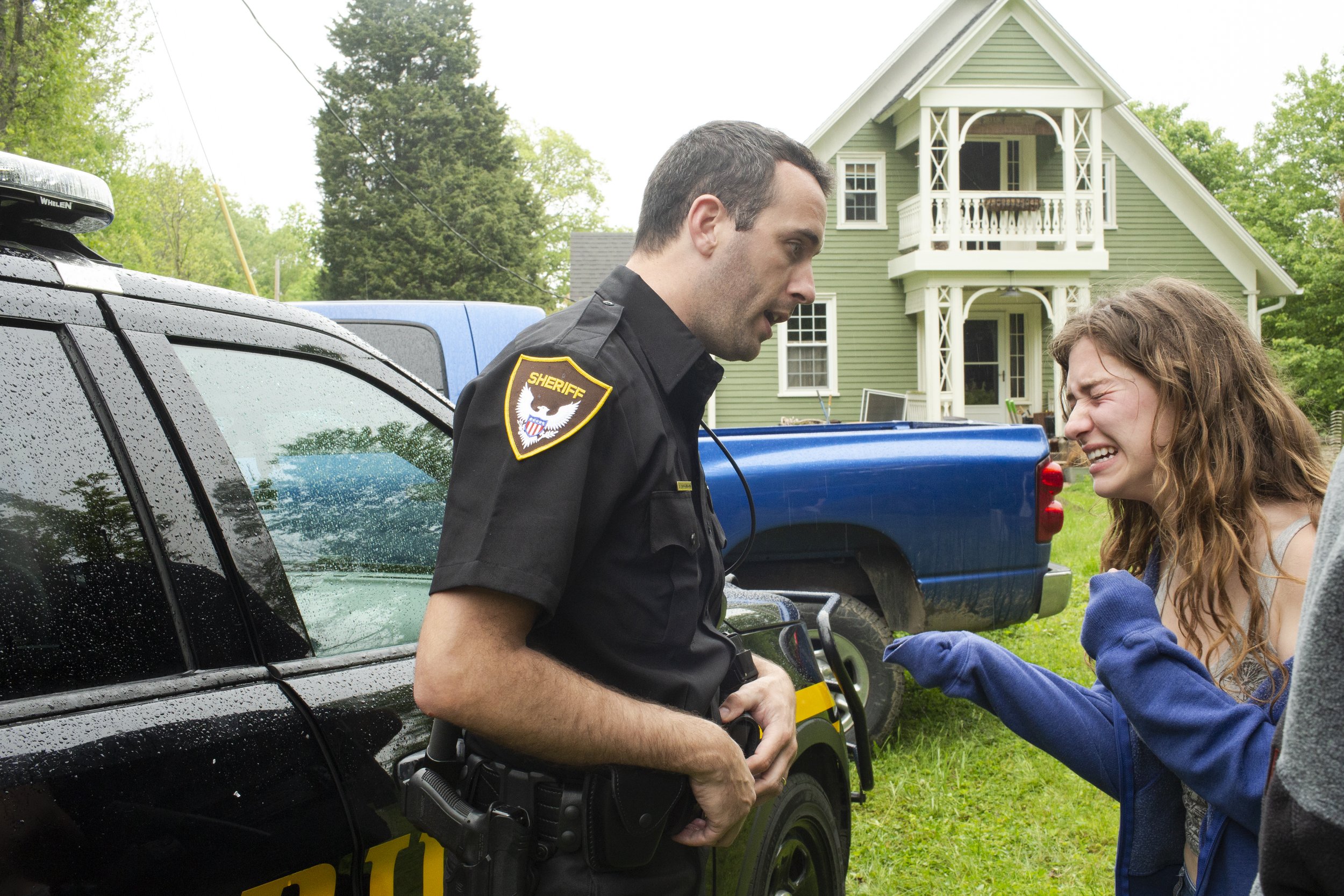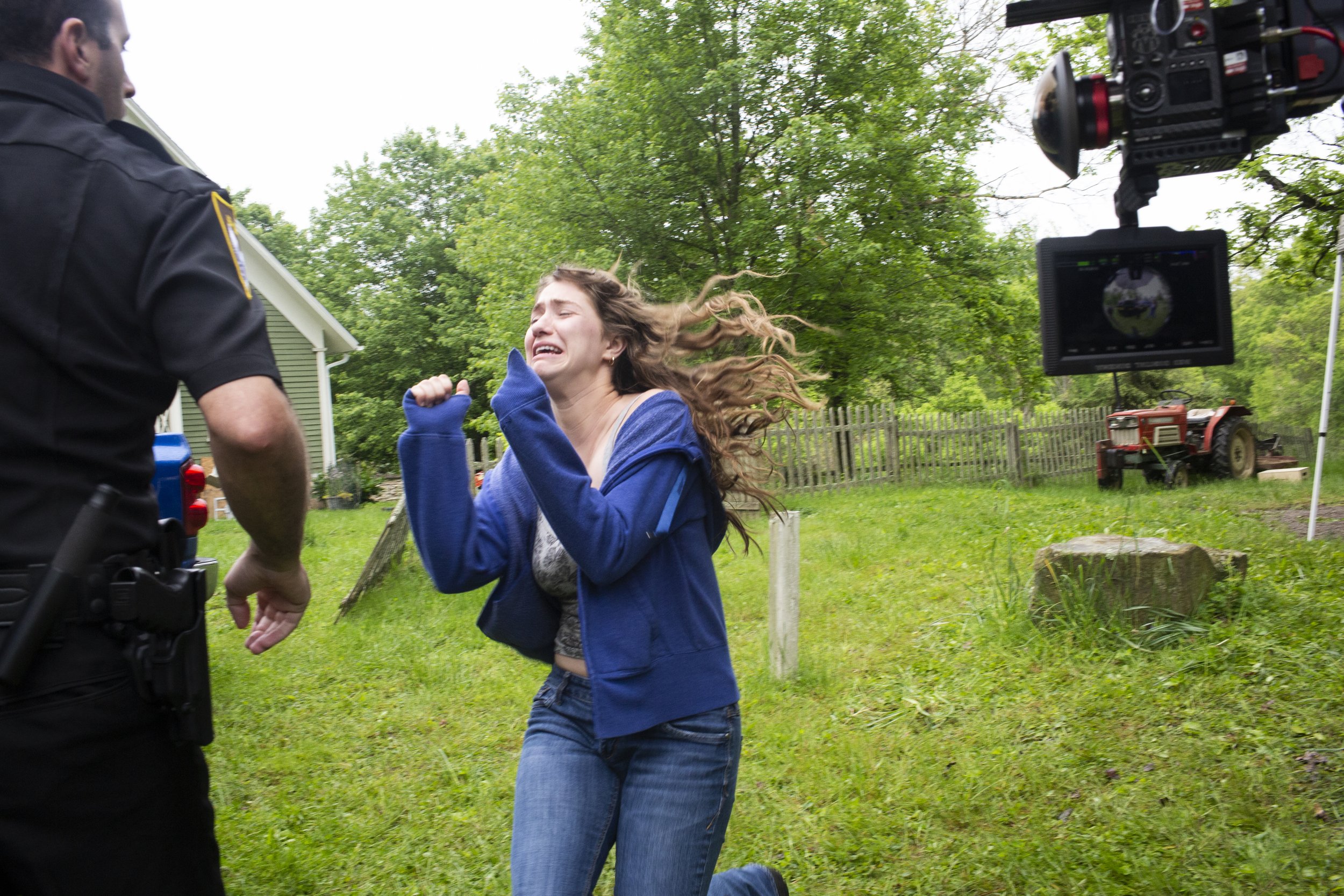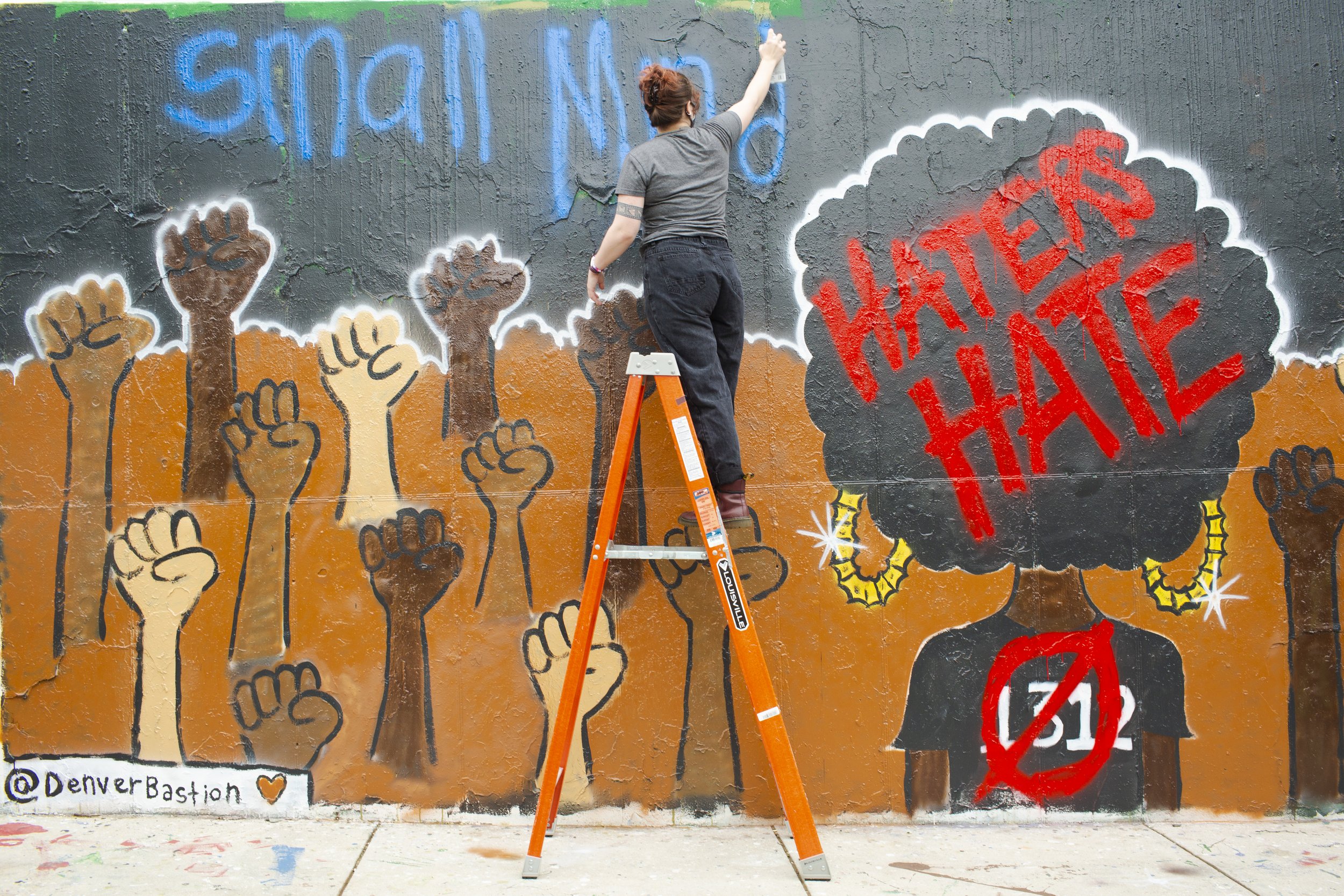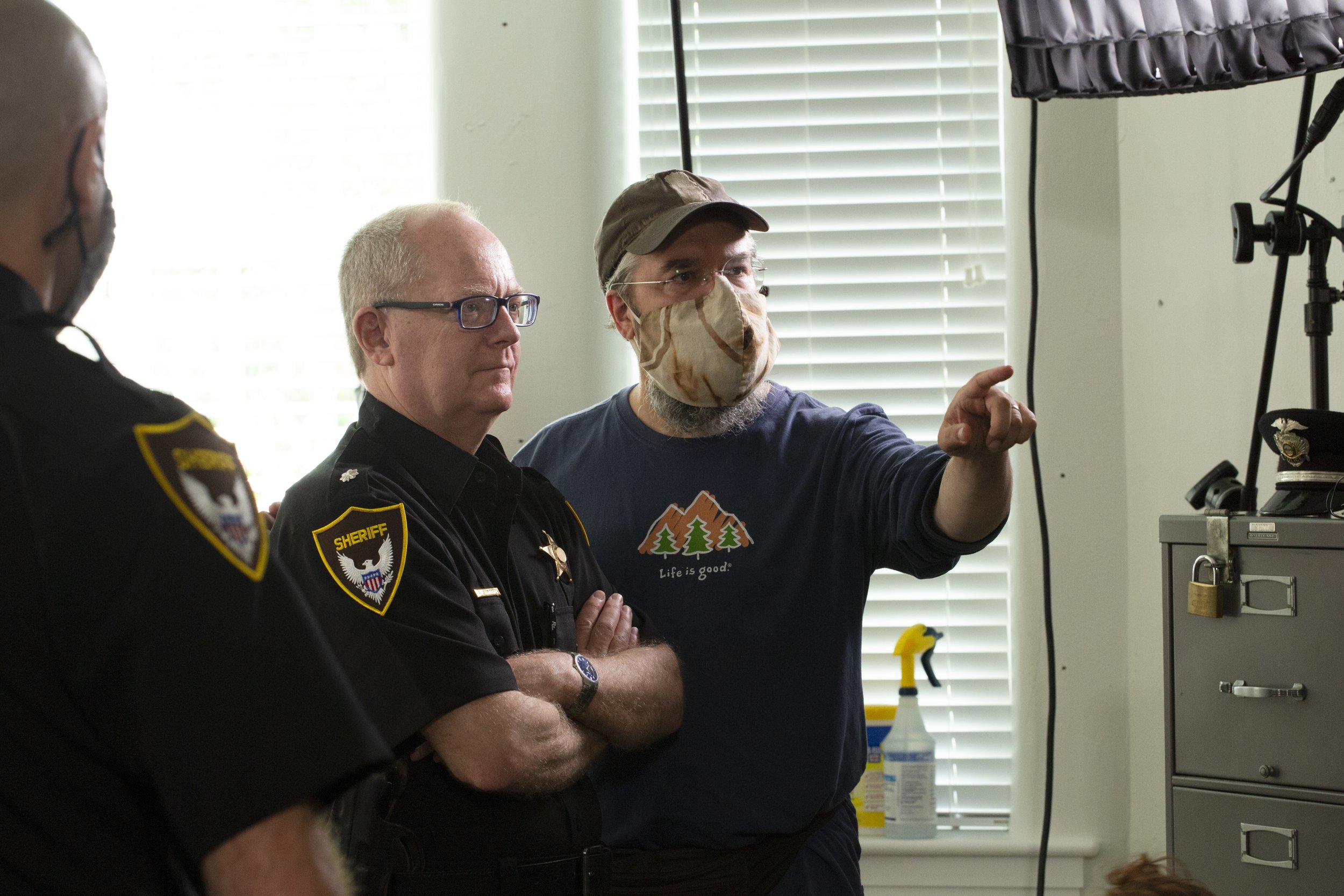Eric R. Williams and his colleagues at the Game Research and Immersive Design (GRID) Lab are pioneering a new approach to police training. Using a combination of cinematic virtual reality, traditional filmmaking, and real-world theatrical props, this revolutionary method connects emotionally and intellectually with its audience, resulting in proven changes to behavior and attitude.
Genesis
The Appalachian Law Enforcement Initiative (or ALEI for short), was the brain child of John Born, former director of the Ohio Department of Public Safety and colonel of the Ohio State Highway Patrol. Born currently works for Ohio University’s Voinovich Academy for Excellence in Public Service, where he met John Bowditch, the director of the GRID Lab. Together they agreed to produce two 30-minute VR experiences that leveraged the GRID’s previous research into a new, cutting-edge approach to cine-VR training.
John Born
John Bowditch
Innovation #1: newest research proves cine-VR changes behavior and attitude
Between 2018-2020, Dr. Liz Beverly – Ohio University’s Heritage College of Osteopathic Medicine Department of Primary Care – collaborated with the GRID Lab on another cine-VR project: the Medicaid Equity Simulation Project (or MESP). MESP combined three forms of entertainment (1. film, 2. cine-VR and 3. live presentation) to teach healthcare providers about their patients’ social determinants of health. The year-long study concluded that the GRID Lab’s approach to cine-VR was distinctly able to improve self-efficacy in its audience. These ground-breaking results were published by the Journal of Medical Internet Research in 2021.
Criteria
Noting the impressive results of the MESP, Bowditch believed that the GRID Lab could adapt this approach to law enforcement. Born agreed, but wanted to make adjustments to meet the need of his target audience of traditionally understaffed rural departments:
The experience had to be bite-sized and free standing – not something that was part of a scheduled program. It needed to be “personal, on the fly training”.
The experience had to be relatively “idiot proof” – not something that needed technical expertise to use. It needed to be as simple as using your TV.
The experience had to “come to the cops” – both mentally and physically. It couldn’t be a message engineered by administrators, and the officers shouldn’t have to wait in line to receive the training.
Innovation #2: technology that is intuitive, free-standing, and easy to use
The GRID Lab developed a distribution approach that allowed each department to customize their own distribution strategy.
Individual VR units were created. Each unit contains one specific story.
The story begins once the headset is deployed. There is no need to use any controls (other than volume).
Hand-held props and an iPad became important aspects of the story and the instructions. See INNOVATIONS, below.
The experiences “live” in a law enforcement department. The officers explore them as part of “roll-call training.”.
“Once a month you put on the head set, placing yourself in other people’s shoes so you can see a different perspective. I call it ‘experience in a box.’ ”
Development
The ALEI scripts were developed over ten months. Bowditch tapped Eric R. Williams (co-director, co-writer and co-producer of MESP) to lead the project. Williams is an award-winning screenwriter (WGA award for best new script) and professor of New Media Storytelling. A recent cine-VR piece that Williams directed won the “Best Virtual Reality Award” in the New York Nil Gallery International Media Festival. Born paired Williams with David Malawista - Forensic Psychologist and Commander of the Athens Police Department.
Innovation #3: developed by cops for cops
Three other officers joined the team from its inception: Lieutenants Tim Ryan and Eric Hoskinson from the Ohio University Police Department, and Captain Aaron Maynard from the Athens County Sheriff’s Office.
Law enforcement advisors from left: Lieutenant Hoskinson, Lieutenant Ryan, Commander Malawista, and Captain Maynard. Photo by M. Westervelt
INNOVATION #4: DEVELOPED WITH Community participation
The development team realized early on that community participation would be an important part of the project. ALEI engaged with the community in three substantial ways:
Tia Jameson, director of Ohio University’s “Bobcats Lead Change” was brought on as the sixth member of the development team.
While most officers in Appalachia are white men, ALEI cast more broadly. 20% of the officers cast were female (1 in 5) and 50% of the commanders cast were non-white (1 in 2). The roles of narrator, council member, and dispatcher were also more diversely cast.
Once actors were in place, Williams used improvisation exercises to fine tune the scenes. Actors Brandyn Bailey and LeJon Woods added enough critical nuance to key scenes that they were given co-writing credit.
Tia Jameson joined ALEI as the sixth member of the development team.
“My goal has always been to assist others to cultivate into their finest self and exceed past what they thought they were capable of.”
In the end, the scenarios and dialogue were developed by an eight-person alliance: four law enforcement officers, three community members and Eric R. Williams as the screenwriter. Together, this creative team developed two thirty-minute cinematic virtual reality experience: The Chet Story and The Dion Story.
Promotional poster for “The Chet Story”. Photo by M. Westervelt
Promotional poster for “The Dion Story”. Photo by M. Westervelt
INNOVATION #5: AUTHENTICITY
The advisory team of officers worked throughout production – ensuring that correct procedures were followed and that the professional actors physically carried themselves as officers would. In addition, 40% of the “field officers” cast in these cine-VR stories were real cops.
Actor Philip C. Matthews consults with David Malawista on set. Photo by M. Westervelt
MFA theater student Philip C. Matthews rehearses. Photo by M. Westervelt
Cincinnati police officer Adam Pape rehearses. Photo by M. Westervelt
While officers polished police procedures with the actors, Williams worked with actors and community members to make other aspects of the scenes as realistic as possible. The cast came from seven different cities (Chicago IL, Louisville KY, Morgantown WV, and Cleveland, Cincinnati, Columbus, and Athens OH) yet they met regularly online to rehearse and discuss the social implications of the project.
LeJon Woods and Brandyn Bailey rehearse a scene, shaping dialogue and actions. Photo by M. Westervelt
Ohio University students act as extras in the protest scene, creating their own posters. Photo by M. Westervelt
Director Eric Williams working on set with actor Dennis Delaney in the role of Commander. Photo by M. Westervelt
Production
Cinematographer (and editor) Matt Love has spent years refining his cine-VR workflow. Using state-of-the-art lenses and a hand-crafted technique for plating his scenes, Matt is able to carefully remove elaborate lighting set-ups that create cinematic quality without drawing the audiences’ attention to the cinematic tools. Williams and Love collaborated on production techniques that pushed the envelope with cine-VR processes:
Adding crane shots and moving car shots
Blocking scenes to force choice within the audience
Unique transition devices to create a sense of “meta” storytelling
Innovation #6: UNIQUE cine-VR techniques
From left to right: Jordan Herron (sound designer), Sondra Boyle (script supervisor), Matt Love (cinematographer), and Stacy Kulikalova (gaffer). Photo by M. Westervelt
Often overlooked in cine-VR production, the sound design for ALEI was crucial to its success. Award-winning sound designer, Jordan Herron (XR Awards finalist for Best Audio in VR – 2021) - and his recording assistant Gokul Muralitharan - created an ambisonic soundscape that served multiple purposes:
Reflecting the emotional state of the central characters during a time of crisis;
Evoking emotion in a story intentionally devoid of music;
Recreating the audio landscape to which law enforcement is accustomed (e.g. scanners, gunfire, private asides) to enhance each story’s authenticity with its central audience.
Actor Tim Perez-Ross on set, painted by Denver Bastion. Photo by M. Westervelt
Cine-VR rig mounted to traveling sheriff’s vehicle. Photo by M. Westervelt
Innovation #7: utilizing the STORY ENGAGEMENT MATRIX
Together, Love and Williams have developed an approach to cine-VR storytelling that manipulates the balance of information and emotion delivered to the audience in any given scene. Based in part on research performed by Katy Newton, Karin Soukup and Paisley Smith at Stanford’s d.school, the approach is outlined in the GRID Lab’s book Virtual Reality Cinema: Narrative Tips and Techniques (2021). In essence, the Story Engagement Matrix controls where in the 360-degree space the storyteller should place information depending on whether they want the audience to remember details of the scene (cognitively) or to remember the feeling of the scene (emotionally). The GRID Lab postulates that it is difficult to do both within the same scene, and therefore the storyteller must carefully craft the experience for maximum impact. The ALEI project, we believe, has struck that balance thereby creating emotionally compelling stories whose key training points are easy to remember.
Story Engagement Matrix / Adonis Durado
PRE-MO iPad graphics by Alvaro Donado, iOS Development by John Bowditch . Photo by S. Lahiri
During post-production, award-winning graphic designer Adonis Durado (Society for News Design, Society of Illustrators, HOW Design Magazine) collaborated with John Bowditch to design the iPad interface. He also collaborated with Love and Williams to design on-screen graphics for the cine-VR stories, and the physical signs that greet the ALEI audience before they put on the headsets. Combined, these graphic elements helped to lay the foundation of the PRE-MO, EMO, RE-MO approach..
implementation
The GRID Lab understands that cine-VR is most effective when it is combined with other forms of entertainment or education. For ALEI, Williams employed the GRID Lab’s “PRE-MO, EMO, RE-MO” technique – which is shorthand for Prepare-Emotion, Emotion, Remembered-Emotion. Each step is a specific storytelling process designed for maximum emotional and cognitive impact.
Innovation #8: pre-mo, emo, re-mo
Complete set up for The Dion Story (items unpacked from the backpack). Photo by S. Lahiri
PRE-MO: Before the audience even begins the experience, they are instructed to find an iPad inside of a physical prop (in The Chet Story, the prop is a lunchbox filled with pictures; in The Dion Story, the prop is a backpack filled with everyday items). Interacting with these props is an important part of the process – as is the iPad itself. In addition to instructions on how to use the VR headset, the iPad provides a five-minute video that introduces the characters and fills the audience in on the backstory. By the end of the video, the audience is (hopefully) engaged in the story, knows who the main characters are, and they are curious about the props they have handled. We have “prepped” their emotional curiosity.
PRE-MO moment removing i-pad from Dion’s backpack. Photo by S. Lahiri
EMO: As soon as the audience dons a VR headset, they are immersed inside Chet’s world or Dion’s world. For 20 minutes, the audience is a fly on the wall, choosing what to watch and who to follow. In Chet’s story they experience his PTSD symptoms, in Dion’s story they experience different confrontational possibilities with the police. In both cases, the character props play a key emotional role in the story (in The Chet Story, a lunchbox filled with pictures; in The Dion Story, a backpack filled with everyday items). It has been well documented that “emotion has a substantial influence on the cognitive processes in humans, including perception, attention, learning, memory, reasoning, and problem solving.”
EMO moment where officer questions Dion about his backpack.
RE-MO: Remember, the ALEI project “lives inside a police department” for up to a month at a time. That means that the headsets and their props (the lunchbox, the backpack) also stay in the police departments. Hopefully, when the officers pass the ALEI set up (day after day, week after week), they see these props. Seeing the props then reminds them of the experience… the characters… and the potential outcomes. By remembering the emotions via the props, the officers are also remembering their training. The story props set the stage, evoke the emotions, and then continuously remind the officers of those emotions.
RE-MO moment when officer revisits backpack and items. Photo by S. Lahiri

























